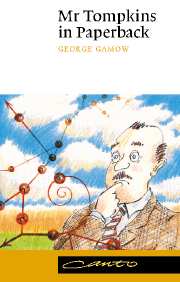Book contents
- Frontmatter
- FOREWORD
- PREFACE
- Contents
- Acknowledgements
- INTRODUCTION
- 1 City Speed Limit
- 2 The Professor's Lecture on Relativity which caused Mr Tompkins's dream
- 3 Mr Tompkins takes a holiday
- 4 The Professor's Lecture on Curved Space, Gravity and the universe
- 5 The Pulsating Universe
- 6 Cosmic Opera
- 7 Quantum Billiards
- 8 Quantum Jungles
- 9 Maxwell's Demon
- 10 The Gay Tribe of Electrons
- 10½ A Part of the Previous Lecture which Mr Tompkins slept through
- 12 Inside the Nucleus
- 13 The Woodcarver
- 14 Holes in Nothing
- 15 Mr Tompkins Tastes a Japanese Meal
10½ - A Part of the Previous Lecture which Mr Tompkins slept through
Published online by Cambridge University Press: 05 June 2013
- Frontmatter
- FOREWORD
- PREFACE
- Contents
- Acknowledgements
- INTRODUCTION
- 1 City Speed Limit
- 2 The Professor's Lecture on Relativity which caused Mr Tompkins's dream
- 3 Mr Tompkins takes a holiday
- 4 The Professor's Lecture on Curved Space, Gravity and the universe
- 5 The Pulsating Universe
- 6 Cosmic Opera
- 7 Quantum Billiards
- 8 Quantum Jungles
- 9 Maxwell's Demon
- 10 The Gay Tribe of Electrons
- 10½ A Part of the Previous Lecture which Mr Tompkins slept through
- 12 Inside the Nucleus
- 13 The Woodcarver
- 14 Holes in Nothing
- 15 Mr Tompkins Tastes a Japanese Meal
Summary
In fact, in the year 1808, an English chemist JOHN DALTON showed that the relative proportions of various chemical elements which are needed to form more complicated chemical compounds can always be expressed by the ratio of integral numbers, and he interpreted this empirical law as due to the fact that all compound substances are built up from a varying number of particles representing simple chemical elements. The failure of medieval alchemy to turn one chemical element into another supplied a proof of apparent indivisibility of these particles, and without much hesitation they were christened by the old Greek name: ‘atoms’. Once given, the name stuck, and although we know now that these ‘Dalton's atoms’ are not at all indivisible, and are, in fact, formed by a large number of still smaller particles, we close our eyes to the philological inconsistency of their name.
Thus the entities called ‘atoms’ by modern physics are not at all the elementary and indivisible constituent units of matter imagined by Democritus, and the term ‘atom’ would actually be more correct if it were applied to such much smaller particles as electrons and protons, from which ‘Dalton's atoms’ are built. But such a change of names would cause too much confusion, and nobody in physics cares much about philological consistency anyway! Thus we retain the old name of ‘atoms’ in Dalton's sense, and refer to electrons, protons, etc. as ‘elementary particles’.
- Type
- Chapter
- Information
- Mr Tompkins in Paperback , pp. 128 - 135Publisher: Cambridge University PressPrint publication year: 1993



